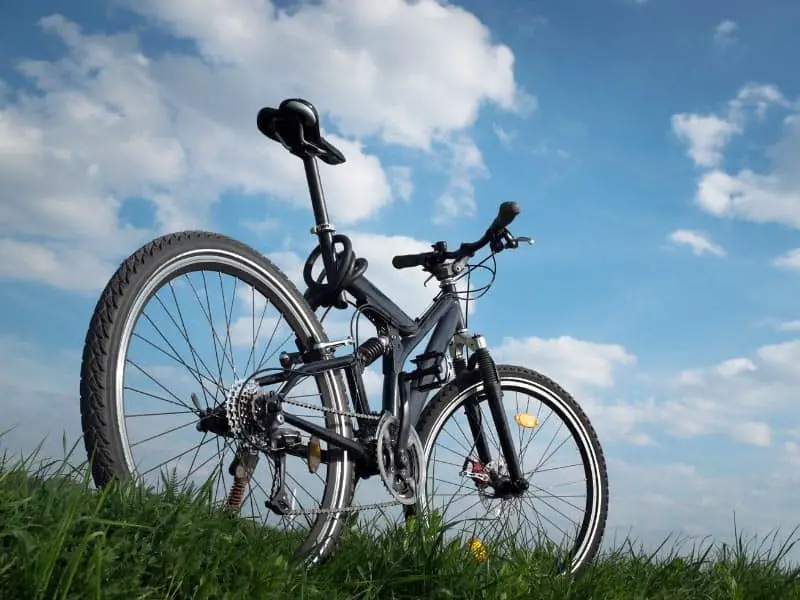Do you want practical ways of increasing cycling efficiency and have reasons why bicycle seats are so high when correctly adjusted? Is your bicycle seat too low right now? Probably. Keep reading to find out why and what you can do about it.
The importance of a higher bicycle seat increases in relation to a rider’s activities and the difficulty of your journeys. A healthy posture benefits every type of bike rider, but it’s especially important for performance, endurance and adventure cycling. If you regularly go out mountain or trail biking, a higher seat will help you get more distance with less physical energy.
Professional bikers are quick to stress the effects of a high bicycle seat for performance. It enables the legs to be fully extended which directs more power into the pedals per stride.
This reduces muscle fatigue and helps you ride longer. Another benefit is healthier knee alignment due to increased flexibility and blood flow.
The short answer is bicycle seats should be set high because a cycling body performs much better in this position. Let’s discuss the physiology behind this in more detail to find out how to make it work for you.
Recommended Gear
To see all of my up-to-date recommendations for bikes and cycling gear, check out this resource that I made for you!
Table of Contents
Why Are Bicycle Seats So High
Getting the height of your bicycle seat right is all about finding the perfect balance between comfort and performance.
If you’ve spent years riding too low, a higher seat might feel uncomfortable at first. It shouldn’t feel painful or unnatural, but it will force your body into a better position for riding.
This means long, outstretched legs that are taking bigger strides and an elevated center of gravity.
Slouching low in the seat might feel easier at first, but it will take its toll in the form of pressure on your knees.
The one exception to this is aerial activities like BMX biking that involve acrobatic body movements.
Riding down steep inclines for prolonged periods or performing jump stunts requires an atypically low seat to guarantee safe clearance.
On BMX style bikes, the seat is rarely used and not needed for efficiency over long distances like it is on a mountain bike.
1 – Better Performance
Cycling with a high bike seat allows your legs to be used to their fullest potential.
It becomes easier to apply precise amounts of force when required and exercise control over the bike’s speed on variable trails.
With a fuller range of motion in the legs, you will have more control over acceleration, deceleration, and safe stopping.
Top Tip: Each pedal on your bike functions as a power transmitter. Learning how to achieve more (accelerating, turning, etc) with smoother, more focused movements will improve your performance on tight, technical trails.
2 – Reduced Fatigue
The tougher the trail, the quicker fatigue sets in. Yet, with the appropriate seat height, you can generate more power per pedal and cover more distance before fatigue starts to affect your performance.
When the bike seat is high, the legs and knees extend through a full range of motion and, when fully extended, the calves stretch.
At the top of the down stroke, the calf muscles lengthen and the tension from the previous pedal gets released right before it builds again for the next one.
Top Tip: These fuller, longer pedals might feel like more effort at first, but they give the leg muscles a mini recovery moment after every down stroke. When the legs can’t fully extend because the seat is set too low, the calf muscles don’t lengthen, tension remains, and this accumulates and increases fatigue. Think of your legs as a pair of old-fashioned fireplace bellows; they need to be completely emptied to be completely full of potential again.
3 – Faster Cycling With More Distance
Having a complete range of motion in the legs when seated high increases the number of strokes per minute while cycling.
This gives more power to rotations, generates more control, and allows you to achieve more pedal power to increase your speed in less time.
Top Tip: On longer bike rides, building up rotations with a period of sustained, controlled pedaling is a great way to create the conditions for cruising. It’s a common trick that professional cyclists use to rest without stopping. Just make sure your leg muscles stay extended at the peak of all that kinetic energy, prepared to turn potential into the next powerful down stroke.
4 – Healthier Knee Alignment
Long distance cycling places significant stress on the knees and, when a bike’s seat is positioned too low, they hardly move at all.
They are involved with generating the power and potential, but remain contracted, and all of that energy and tension stays trapped in the muscles because their motion is so limited.
It’s all about performing full and complete movements. Shallower, compressed motions reduce circulation and lead to less efficient muscle contractions and releases.
Top Tip: Cycling with a high bicycle seat won’t stop your knees from getting fatigued. This activity is one of the hardest on the knees, but it will release all of the built-up energy and tension on every down pedal. You’ll be able to travel greater distances in less time, so fatigue should be less of a problem. Tackle soreness by getting more out of your body for less.
5 – Increased Control
The key to making a bike go much faster is to place as little extra stress on it as possible.
Your weight is a significant strain on a bike’s ability to move quickly but remaining agile and responsive is the right way to neutralize this pressure.
When a seat stays high, your center of gravity stays high too. Instead of hauling your center of gravity upwards and then shifting your weight to turn, balance or accelerate, it stays centered and ready.
Top Tip: Keeping your bike seat high will allow you to generate changes in momentum and direction in a much faster and responsive manner. However, it is important to achieve a good fit. If the bicycle’s seat is too high for your height, handling and cornering will suffer because your center of gravity will be too high. Relatively small shifts in weight will lead to uncontrolled movements. Skilled weight balancing is essential when riding technical trails with tight corners.
6 – Balanced Weight Distribution
Bikes are lightweight vehicles made to move through the air at top speeds. They’re perfectly designed for it. Unfortunately, human beings are not.
Getting a bike to go faster requires efficient weight distribution and economy of movement or, rather, generating more power out of less physical force.
When a bike’s seat is too low, your center of gravity stays low. Instead of remaining balanced at its center, it drops towards the back of the bike and pulls it downward.
Imagine getting up from a very low sofa with worn springs. It requires more energy because you are pulling your center of gravity further to reach equilibrium.
7 – Better Center of Gravity
With a lower seat height, you will have an imbalanced center of gravity which leads to much slower responses and sloppier cornering and control.
In a low seat, your body isn’t centered or ready to shift its weight at the necessary moments.
It takes longer to redistribute your weight in the saddle, recapture your sense of balance and then perform the turn.
The slower your body’s response time, the less likely the turn or maneuver is to be successful.
For this reason, a higher bike seat can be much safer, particularly on challenging terrains or trails with lots of tight corners.
It’s worth remembering that every labored maneuver made with more energy than necessary leads to fatigue and soreness.
8 – Release Tension From Your Muscles
Nobody is suggesting that raising a bicycle’s seat is a magic cure for tiredness. Cycling is a strenuous activity that places great strain on the muscles and joints over long distances.
Endurance cycling requires mastery over the body with every squeeze, push, twist, and turn transformed into precise, impactful movements.
Your legs are the key to all of this and using them effectively will help you become a more capable cyclist.
Keep your bike seat high enough for your legs to extend into the lock out position.
As you stretch them out on the downward stroke, you’re releasing tension and increasing the kinetic energy potential before the next contraction and pedal push. You’re getting more distance for less effort.
9 – Less Strain On Your Joints
Like the calf muscles, the knee joints are under a lot of strain when cycling.
They can pick up injuries quickly and even superficial (non-muscular) damage may affect performance by persuading you to protect a sore joint and favor the other.
The best way to avoid knee injuries, and recover from superficial damage, is to regain that complete range of motion.
The fuller the stretches and extensions are, the better the circulation will be in your legs. Soreness and injuries become more likely as the blood flow to fatigued areas decreases, so try to avoid cramped, contracted knees.
Finding Your Optimal Seat Height
When I say your bicycle seat should be high, I don’t necessarily mean as high as it will physically go.
A rider who’s over six feet tall won’t have the same optimum height as a rider who’s closer to five feet. Clearly, the taller you are, the higher your bike seat can go without things getting uncomfortable.
Here are some general rules of thumb you can use to work out your optimum seat height.
With a clipless pedal, there should be a soft bend in each knee (approximately 150°) when the corresponding foot is at the bottom of the push stroke.
For bicycles with platform pedals, position your heel on the center of the pedal’s axle and rotate the pedal to the bottom of the push stroke.
Your knees should comfortably lock out if your seat is correctly adjusted with the ball of each heel just about reaching the pedal.
If you can’t lock your knees, the bike seat is too low. If you can’t touch the pedals, it’s too high for your height.
Helpful Tips To Know Why Bicycle Seats Are So High
- Reducing Discomfort: Back, hip and knee pain are more likely when cyclists ride in a saddle that’s too low for their height.
- Avoiding Injury: The repetitive nature of cycling leads to a greater risk of strain injuries and muscle conditions such as tendonitis, so it’s important to exercise a full range of motion and ensure muscles and joints are stay active and not tense and contracted in the prolonged cramped positions.
- Improving Performance: Even a slight difference in seat height makes a significant difference to cycling efficiency and performance. It increases the amount of power generated per pedal and achieves more distance for less physical exertion and soreness.
Final Thoughts
This article has covered the most important reasons why you need to correctly set your bicycle seat higher, so it isn’t too low.
If you really want to push yourself and achieve optimum performance out on the trails, resist the urge to ride lower. It might feel easier at first, but it’s a fast ticket to a slower ride.


